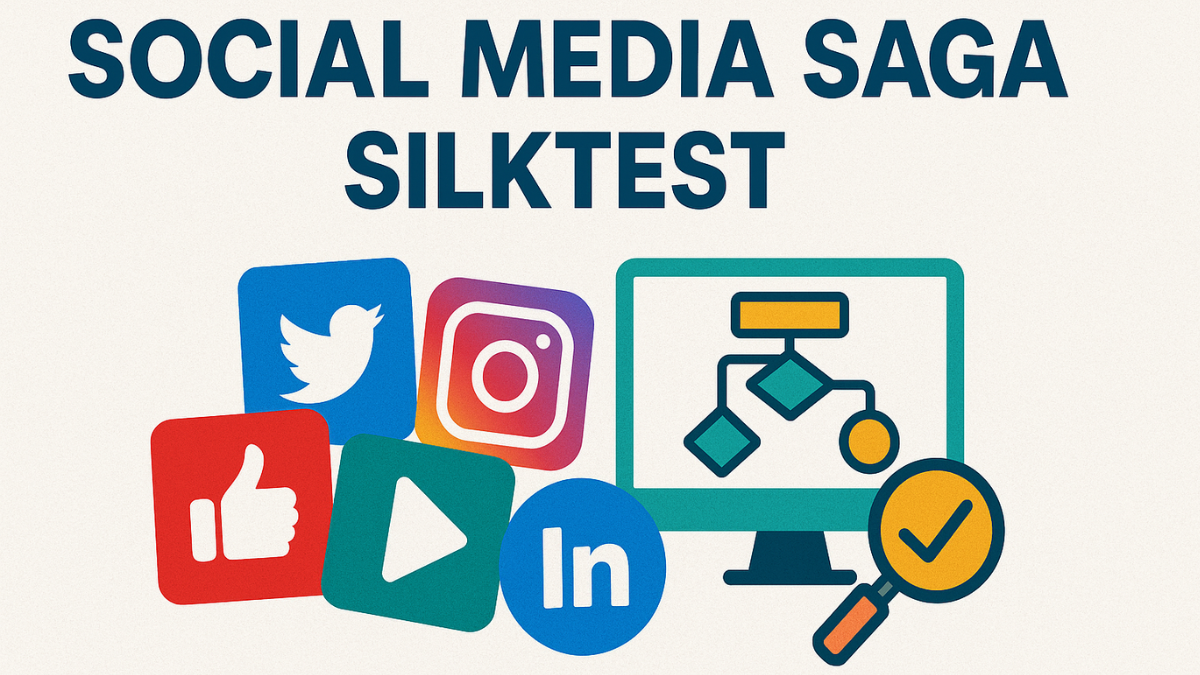Explore the complete story behind the social media saga silktest – from digital evolution to testing strategies. Learn how automation enhances user experience across social platforms.
also read:https://usaenliinea.com/cougarweb-everything-you-need-to-know-about-this-online-student-portal/
Introduction to the Social Media Saga Silktest
In the ever-evolving world of digital technology, the rise of social media platforms has been nothing short of a saga. Coupled with advancements in testing tools like SilkTest, the journey becomes even more remarkable. Understanding the term “social media saga silktest” requires diving into both the narrative of social media’s growth and the role of testing software in ensuring quality, security, and performance.
This article explores how social media’s explosive growth led to complex digital systems that required reliable testing tools like SilkTest. Together, these elements form a compelling digital saga that has reshaped online communication, commerce, and automation.
What is the Social Media Saga?
The term “social media saga” refers to the chronological growth, challenges, and transformation of platforms like Facebook, Instagram, Twitter (now X), LinkedIn, and TikTok. What started as a way to connect with friends has turned into a powerful global force influencing culture, politics, and business.

The saga consists of several key phases:
1. Birth of Social Platforms
In the early 2000s, platforms like MySpace and Orkut paved the way for user-based content sharing. The user interface was simple, but the social impact was profound.
2. Expansion & Monetization
By 2010, platforms like Facebook and YouTube had grown into billion-dollar ecosystems. This period introduced monetization strategies like paid ads, influencer marketing, and sponsored content.
3. Challenges & Privacy Concerns
Massive user data collection sparked global debates around privacy and misinformation. Incidents like the Cambridge Analytica scandal marked a turning point in user trust.
4. Regulation & Responsibility
In the late 2010s, governments began to regulate content, enforce GDPR, and promote ethical platform usage. Social media companies started investing heavily in AI and machine learning to monitor content.
5. Integration with Automation Tools
This phase is where SilkTest enters the picture — ensuring the performance, compatibility, and reliability of social media platforms through automated testing.
Introduction to SilkTest
SilkTest is a functional and regression testing automation tool by Micro Focus. It’s designed to ensure that web, mobile, and enterprise applications run smoothly under various conditions.
SilkTest’s contribution to the social media saga lies in its ability to:
- Test dynamic user interfaces
- Perform cross-platform testing
- Simulate user behavior under various environments
- Detect performance issues before live deployment
This makes SilkTest a critical component in managing large-scale social media applications where millions of users interact daily.
How SilkTest Supports Social Media Platforms
For social media platforms that require constant updates and enhancements, maintaining a seamless user experience is non-negotiable. Let’s break down how SilkTest aids in achieving this.
Functional Testing
Social media apps have numerous interactive elements: comment sections, video players, like buttons, and more. SilkTest tests each component’s functionality across different browsers and devices.
Regression Testing
Whenever a platform updates its code, there’s a risk of breaking something that previously worked. SilkTest ensures that older features remain intact after updates.
Cross-Browser Compatibility
Not all users access social media the same way. SilkTest verifies platform behavior on Chrome, Firefox, Safari, and Edge, ensuring a consistent experience.
Stress & Load Testing
With millions of active users, load testing is vital. SilkTest can simulate thousands of users performing actions simultaneously to evaluate performance.
Table: SilkTest vs. Manual Testing in Social Media
| Feature | SilkTest (Automated) | Manual Testing |
|---|---|---|
| Speed of Execution | Very Fast | Slow |
| Accuracy | High (No human error) | Prone to mistakes |
| Reusability of Scripts | Yes | No |
| Cost in Long Run | Cost-effective | Expensive over time |
| Ideal for Regression Tests | Absolutely | Not Practical |
This comparison proves why automated tools like SilkTest are essential in managing the complex backend of social media applications.
Case Study: Social Media Platform Using SilkTest
Imagine a global platform like TikTok releasing a new feature that allows video replies to comments. Before releasing it to millions of users, they need to ensure:
- The reply button works across iOS, Android, and web
- The video reply uploads correctly
- Users receive proper notifications
- The feature does not crash under heavy usage
Using SilkTest, developers can simulate these conditions and validate performance without relying on a massive manual testing team. The result? Faster deployments, better reliability, and fewer user complaints.
Why the “Social Media Saga Silktest” is Important in 2025
In today’s digital world, users expect flawless performance and immediate updates. Any glitch or lag can lead to backlash, lost revenue, and damage to brand trust.
The term “social media saga silktest” isn’t just a buzzword. It represents a symbiotic relationship between digital storytelling and technology testing. As platforms evolve, tools like SilkTest evolvetoo—becoming smarter, faster, and more integrated with DevOps pipelines.
List of Benefits of Using SilkTest in the Social Media Environment
- Faster Time-to-Market – Speeds up testing cycles and feature releases.
- Cost Reduction – Reduces the need for large QA teams.
- Enhanced Accuracy – Eliminates human error during repetitive tasks.
- Scalability – Can handle testing for millions of users’ scenarios.
- Security Checks – Ensures APIs and user data remain secure.
- 24/7 Testing – Automated scripts can run overnight for global teams.
- Real-Time Reporting – Provides visual dashboards for tracking issues.
Challenges of Combining Social Media and Automation
Despite the advantages, there are challenges when integrating tools like SilkTest:
- Dynamic Content: Social media apps update frequently, requiring adaptable scripts.
- UI Changes: A minor design shift can break automated tests.
- Maintenance Overhead: Scripts must be regularly updated to match platform changes.
- Learning Curve: Teams need to be trained to use SilkTest effectively.
However, with proper planning and continuous integration (CI/CD) systems in place, these challenges can be mitigated.
FAQs about Social Media Saga Silktest
1. What does the term “social media saga silktest” actually mean?
It refers to the historical growth of social media platforms and the role SilkTest plays in testing and automating their development processes.
2. Is SilkTest suitable for mobile app testing for social media?
Yes, SilkTest supports mobile platforms, enabling robust testing for Android and iOS social media apps.
3. Can SilkTest be used for security testing?
While it’s primarily used for functional testing, it can identify flaws that may affect application security.
4. Is SilkTest open source?
No, SilkTest is a commercial product offered by Micro Focus.
5. How does SilkTest handle real-time user behavior simulations?
It uses record and playback methods along with scripting to simulate user actions across different environments.
6. Are there alternatives to SilkTest for social media testing?
Yes, tools like Selenium, TestComplete, and Katalon are popular alternatives, but SilkTest offers enterprise-grade capabilities.
7. Can SilkTest integrate with CI/CD pipelines?
Absolutely, it can be integrated with tools like Jenkins and Git for continuous testing and deployment.
8. What languages are supported by SilkTest scripting?
SilkTest primarily uses 4Test, a proprietary scripting language, and integrates with VB.NET and C#.
9. How often should automated tests be updated for social media platforms?
Whenever a UI or feature change occurs, test scripts should be updated to reflect the changes.
10. Can SilkTest handle visual testing?
It supports basic visual verifications but may need integration with tools like Applitools for advanced visual testing.
Conclusion: The Future of Social Media and SilkTest
The combined narrative of social media saga silktest symbolizes more than just technical evolution. It’s about how digital platforms maintain trust, engagement, and performance through sophisticated automation.
also read: https://usaenliinea.com/marsbahis-a-detailed-guide-to-turkeys-leading-online-betting-site-in-2025/
As we move into an era where user expectations are sky-high and downtime is unacceptable, tools like SilkTest ensure that social media platforms remain reliable and scalable. The saga continues, and automation will always play a leading role in its next chapters.
also read: https://usaenliinea.com/who-is-behind-2489040311-full-analysis-lookup-and-safety-tips/
also read: https://usaenliinea.com/michael-mcbride-lll-news-oklahoma/
also read: https://usaenliinea.com/understanding-the-block-demand-calculator-in-niagara-4-vykon-pro/







